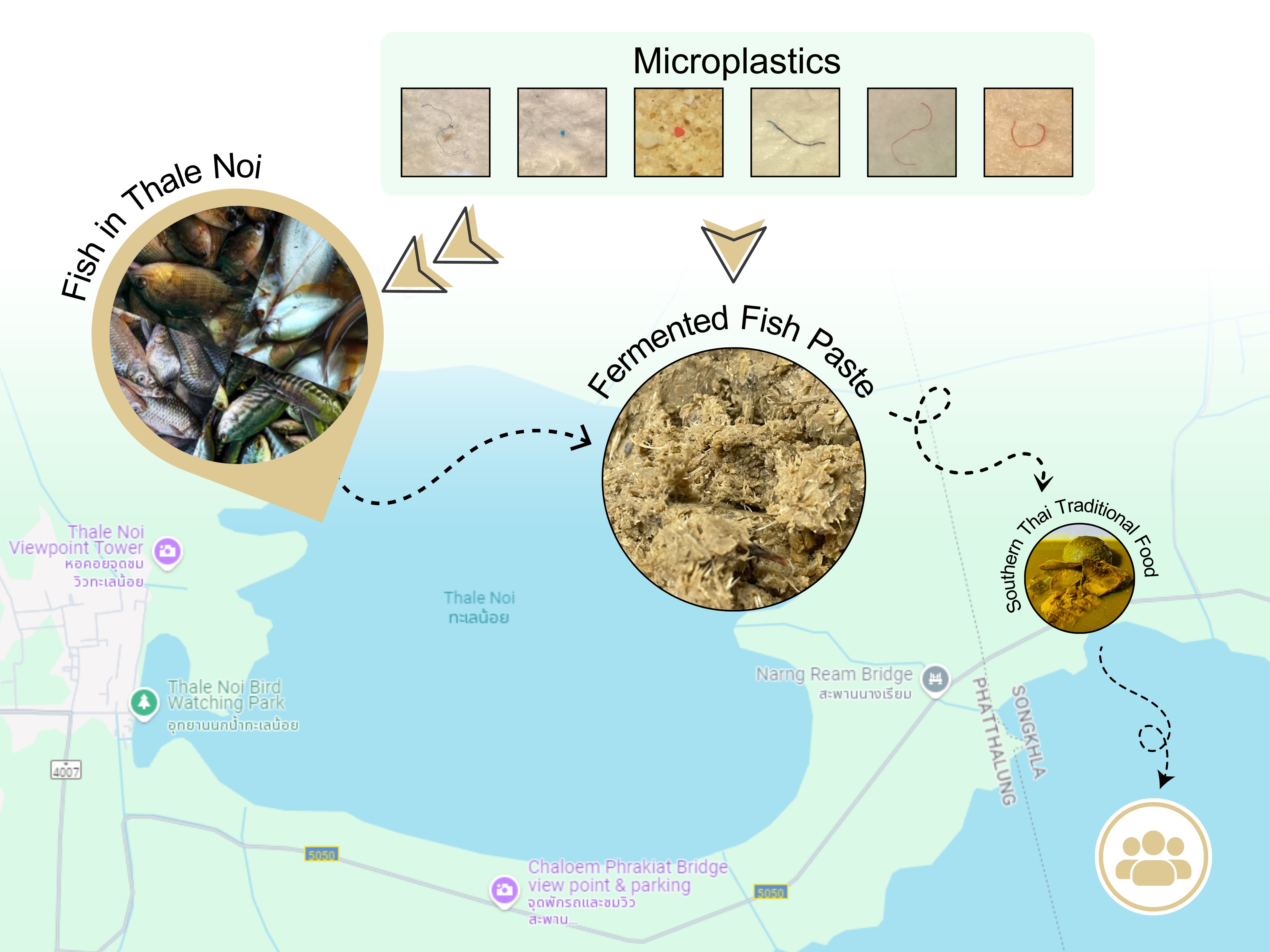Microplastic Contamination in Fish and Fermented Fish Paste in the Thale Noi Area: Analysis and Mitigation Approaches
Keywords:
microplastic, fish, fermented fish paste , community product , food safetyAbstract
Background and Objectives: The Thale Noi area is a significant eco-tourism destination in Phatthalung Province, attracting many tourists. Additionally, many households reside around Thale Noi, leading to substantial waste generation from both domestic activities and tourism. This waste can enter nearby water sources, where plastic waste may gradually degrade into microplastics. Microplastics are small plastic particles with a diameter of fewer than 5 millimeters. They can contaminate ecosystems and negatively affect the quality of local community products, particularly traditional food items. Thale Noi is a vital wetland area that serves as a water catchment and supports tourism, fishing, and agriculture. The local community relies on fish from Thale Noi to produce various products, particularly fermented fish paste, locally known as "kapi pla". Since whole fish are used in the production process, there is a potential risk of microplastic contamination. Fermented fish paste is a highly popular product among both locals and tourists. This study investigates microplastic contamination in fish commonly used for fermented fish paste production, microplastic contamination in the fermented fish paste itself, and the production process of fermented fish paste. The objective is to develop guidelines for improving production methods to minimize microplastic contamination, ensuring safer products. This will enhance the safety and quality of fermented fish paste from Thale Noi, adding value to this important local product in the future.
Methodology : The study of microplastic contamination in fish and fermented fish paste, as well as the production process of fermented fish paste in the Thale Noi area, was exploratory research combined with laboratory analysis. Fish samples were collected from five species commonly used by local communities to produce fermented fish paste: Trichogaster trichopterus, Puntius gonionotus, Trichogaster pectoralis, Barbodes schwanenfeldi, and Pristolepis fasciata, with 60 samples per species. For the study of microplastic contamination in fermented fish paste, samples were randomly purchased, and data were obtained from five producers, with three samples per producer. Data collection was conducted every two months for fish and fermented fish paste, resulting in 1,800 fish samples and 90 fermented fish paste samples. Fish and fermented fish paste samples were prepared for further analysis to determine the microplastics' quantity, color, and shape, contaminating both fish and fermented fish paste. Additionally, the production process of fermented fish paste was studied, focusing on key processes such as the main fish species used, equipment for chopping fish, tools for fermenting fish paste, tools for grinding or mincing fish, drying equipment, fermentation duration, drying duration, and containers for storing fermented fish paste. Data analysis was conducted to compare differences in the amount of microplastic contamination between fish species and between microplastic contamination in fermented fish paste and various production methods. The One-Way ANOVA method was used, followed by the Duncan multiple range test to compare differences across fish species and production processes at a significance level of 0.05. Data analysis was performed using Microsoft Excel. The study aimed to identify the fish species with the lowest microplastic contamination as a recommendation for selecting raw materials for fermented fish paste production.
Main Results : The fermented fish paste was found to have an average microplastic contamination of 115.0 ± 119.7 pieces/kg. Among the fish species commonly used as raw materials for fermented fish paste production, Puntius gonionotus exhibited the highest microplastic contamination, averaging 365.5 ± 276.0 pieces/kg, followed by Barbodes schwanenfeldi with an average of 321.8 ± 224.1 pieces/kg. The lowest level of microplastic contamination was observed in Trichogaster pectoralis at an average of 162.2 ± 108.0 pieces/kg. A comparison of microplastic contamination among the five fish species using One-Way ANOVA at a significance level of 0.05 revealed statistically significant differences. Post hoc analysis showed that most fish species exhibited significantly different levels of microplastic contamination at the 0.05 significance level, except for the following pairs, where no significant difference was observed: Trichogaster trichopterus and Trichogaster pectoralis, Puntius gonionotus and Barbodes schwanenfeldi, Puntius gonionotus and Pristolepis fasciata, and Barbodes schwanenfeldi and Pristolepis fasciata. Additionally, smaller fish were found to have higher levels of microplastic contamination compared to larger fish, particularly in Puntius gonionotus, Trichogaster pectoralis, Barbodes schwanenfeldi, and Pristolepis fasciata. Black-colored microplastics and fiber-shaped microplastics were the most prevalent contaminants in both fish and fermented fish paste. Furthermore, the equipment used in the production process of fermented fish paste significantly influenced microplastic contamination levels. Specifically, equipment used for chopping, fermenting, and drying the fermented fish paste contributed to higher microplastic contamination. The use of plastic equipment in these processes resulted in significantly higher microplastic contamination at a confidence level of 0.1.
Conclusions : To reduce microplastic contamination in fish paste and improve processing methods, it is recommended to select fish species used as raw materials carefully. Puntius goionotus, Barbodes schwanenfeldi, and small fish should be avoided. Production equipment should be made from wood or other non-plastic materials to minimize contamination. Avoiding the use of plastic tools in the production process will help reduce microplastic contamination, thereby enhancing the safety and quality of local food products.
References
Andrady, A. L. (2011). Microplastics in the marine environment. Marine Pollution, 62, 1589-193.
Barnes, D.K.A., Galgani, F., Thompson, R.C. & Barlaz, M. (2009). Accumulation and fragmentation of plastic debris in global environments. Philosophical Transactions of Royal Society B, 364, 1985–1998.
Chusri, W., Thongsawad, S., & Satsue, T. (2020). Developing standards for fish paste to community residents moo 12, Tambon Tha Ruea, Amphur Muang, Nakhon Si Thammarat. Journal of Cultural Approach, 21(40), 65-77. (in Thai)
Department of Fisheries. (2006). Fish Culture of Silver Barb. Bangkok: Cooperative of Agricultural Cooperative Printing of Thailand, Ltd. (in Thai)
Kemteng, S., Kiddee, P., & Sutummawong, N. (2019). Microplastics Contaminated in Puntius goionotus and Arius marculatus at Thale Noi. Research Report: Environmental Science Project Department of Biological and Environmental Sciences, Faculty of Science, Thaksin University. (in Thai)
Kim, C., Lee, S., Jeon, H., Kim, K. Kim, D., Lee, H. Park, S. & Lee, S. (2024). Microplastic characterization in small freshwater fishes collected in Gyeongan-cheon, a tributary stream of Han River in South Korea: Ingestion and depuration study of Nylon. Environmental Pollution, 363(Part 1), 125044.
Kim, L., Kim, H., Kim, T., & An, Y. (2025). Size- and shape-dependent effects of polyethylene terephthalate microplastics on the benthic crustacean Artemia franciscana. Marine Pollution Bulletin, 211, 117391.
Leslie, H. A., van Velzen, M.J.M., Brandsma, S.H., Vethaak, A.D., Garcia-Vallejo, J.J., & Lamoree, M.H. (2022). Discovery and quantification of plastic particle pollution in human blood. Environment International,163,107199.
Mathalon, A., & Hill, P. (2014). Microplastic fibers in the intertidal ecosystem surrounding Halifax Harbor, Nova Scotia. Marine pollution bulletin, 81(1), 69-79.
Okamoto, K., Nomura, M, Horie, Y., & Okamura, H. (2022). Color preferences and gastrointestinal-tract retention times of microplastics by freshwater and marine fishes. Environmental Pollution, 304, 119253.
Özsoy, S., Gündogdu, S., Sezigen, S., Tasalp, E., Ikiz, D.A., & Kideys, A.E. (2024). Presence of microplastics in human stomachs. Forensic Science International, 364, 112246.
Prempridi, S., Khawsang, S. & Thammakirati, N. (2017). Study of Microplastics in Short Mackerel (Rastrelliger brachysoma) at Hat Chao Mai National Park, Trang Province. Marine National Park Operation Center 3, Trang Province.
Schwabl, P., Köppel, S., Königshofer, P., Bucsics, T., Trauner, M., Reiberger, T., & Liebmann, B. (2019). Detection of Various Microplastics in Human Stool: A Prospective Case Series. Annals of Internal Medicine. 171(7) 453-457.
Tanaka, K., & Takada, H. (2016) Microplastic fragments and microbeads in digestive tracts of planktivorous fish from urban coastal waters. Scientific Reports, 6, 34351.
Wongroj S. (2004). A Taxonomic study on the Freshwater fishes in the eastern area of Bangkok. Graduate School, Srinakharinwirot University. (in Thai)
Xiong X., Tu, Y., Chen, X., Jiang, X., Shi, H., Wu, C., & Elser, JJ. (2019). Ingestion and egestion of polyethylene microplastics by goldfish (Carassius auratus): influence of color and morphological features. Heliyon, 5(12), e03063,

Downloads
Published
How to Cite
Issue
Section
License
Copyright (c) 2025 Faculty of Science, Burapha University

This work is licensed under a Creative Commons Attribution-NonCommercial-NoDerivatives 4.0 International License.
Burapha Science Journal is licensed under a Creative Commons Attribution-NonCommercial-NoDerivatives 4.0 International (CC BY-NC-ND 4.0) licence, unless otherwise stated. Please read our Policies page for more information



